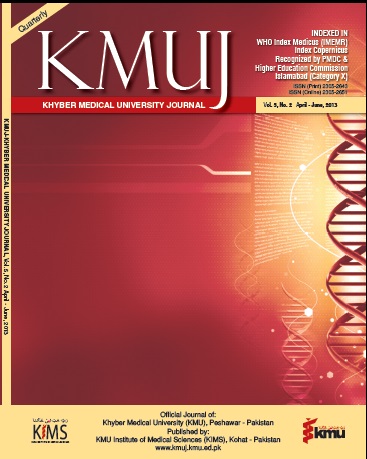PARAMETERS ASSESSED FOR QUALITY AND MANAGEMENT OF MODULAR SYSTEM BY THE STUDENTS OF FIRST AND SECOND YEAR MBBS
Main Article Content
Abstract
OBJECTIVE: To assess the quality and management of the modularsystem in the first two years of Islamic international medical collegeRawalpindi.
METHODOLOGY: Based on convenience sampling, 180 students of firstand second year MBBS of Islamic International medical college Rawalpindiwere given proforma at the end of each module and evaluated bythe evaluation committee.
RESULTS: First year students, showed agreement for objectives ofthe module, integration of theory & practical’s, and for grasping of themodule. They were dissatisfied with the time management of the topiccompletion. Second year students were dissatisfied with integration oftheory & practical’s. Students of first year strongly disagreed (11.2%)that assessment reflects the objectives in contrast to 2nd year (8.8 %).Captivation of interest of module content agreement was 44% for 1styear student’s vs 29.7% for 2nd year. Strong agreement for the reflectionof objectives was 20.5% of 1st year students vs 1.1% for 2nd year students.Second year was satisfied with the PBL content (20.6%). Strongagreement was shown by 12.2% of 1st year students as compared to 5.5% of 2nd year that it encouraged the thinking process.
CONCLUSION: Overall students are satisfied with the modular system.First year students are not satisfied with the time management of thetopic completion, content of the module and assessment reflecting theobjectives. Second years students were more satisfied than 1st yearstudents except for integration of theory & practicals. Efforts are neededto address the students concerns regarding modular system.
Article Details
Work published in KMUJ is licensed under a
Creative Commons Attribution 4.0 License
Authors are permitted and encouraged to post their work online (e.g., in institutional repositories or on their website) prior to and during the submission process, as it can lead to productive exchanges, as well as earlier and greater citation of published work.
(e.g., in institutional repositories or on their website) prior to and during the submission process, as it can lead to productive exchanges, as well as earlier and greater citation of published work.
References
Flexner A. Medical Education in the United
States and Canada: A Report to the Carnegie
Foundation for the advancement of
Teaching, 1910. Bulletin No. 4, New York
City: The Carnegie Foundation for the
Advancement of Teaching.
Schmidt HG. Problem-based learning:
rationale and description. Med Edu 1983;
: 11-6.
Mostafa M. El-Naggar, Hussein A, Mohamed
AS, Hamdy D, Waleed AM.Developing an integrated organ/system
curriculum with community-orientation
for a new medical college in Jazan, Saudi
Arabia. J Family Community Med 2007;
(3): 127-36.
Sandila MP, Siddiqui NA, Bawa MT, Huda
N. An integrated curriculum for MBBS. J
Pak Med Assoc 2001; 51(2): 60-3.
Ghayur S, Rafi S, Khan AH, Ahmad RN,
Iqbal M. Delivering endocrinology and
reproduction in an integrated modular
curriculum. J Pak Med Assoc 2012; 62(9):
-41.
Middle States Commission on Higher
Education. Student Learning, Assessment.
Options and Resources. Second Edition.
Middle States Commission on
Higher Education, Philadelphia.
Chumley-Jones HS, Dobbie A, Alford
CL. Web-based learning: Sound educational
method or hype? A review of the
evaluation literature. Acad Med 2002: 77:
S86-93.
Parikh A, McReelis K, Hodges B. Student
feedback in problem based learning: A
survey of 103 final year students across
five Ontario medical schools. Med Educ
; 35(7): 632-6.
Papinczak T, Young L, Groves M, Haynes
M. An analysis of peer, self, and tutor
assessment in problem-based learning
tutorials. Med Teach 2007; 29(5): 122-32.
Brynhildsen J, Dahle LO, BehrbohmFallsberg
M, Rundquist I, Hammar M. Attitudes
among students and teachers on vertical
integration between clinical medicine and
basic science within a problem-based
undergraduate medical curriculum. Med
Teach 2002; 24(3): 286-8.
Vermet S, McGinnis K, Boodham M, GleberzonBJ.
Degree of vertical integration
between the undergraduate program
and clinical internship with respect to
lumbopelvic diagnostic and therapeutic
procedures taught at the Canadian memorial
chiropractic college. J Chiropr Educ
; 24(1): 46-56.
Humphrey SP, Mathews RE, Kaplan AL,
Beeman CS. Undergraduate basic science
preparation for dental school. J Dent Educ
; 66(11): 1252-9.
Mierson S. A problem-based learning
course in physiology for undergraduate
and graduate basic science students. Am J
Physiol 1998; 275 (6 Pt 2): S16-27.
He X, La Rose J, Zhang N. Integrated
neuroscience program: an alternative
approach to teaching neurosciences to
chiropractic students. J Chiropr Educ
; 23: 134–46.
Custers EJ, Cate OT. Medical students’
attitudes towards and perception of the
basic sciences: a comparison between
students in the old and the new curriculum
at the University Medical Center Utrecht,
The Netherlands. Med Educ 2002; 36:
-50.
Ghosh S, Pandya HV. Implementation of
Integrated Learning Program in neurosciences
during first year of traditional
medical course: perception of students
and faculty. BMC Med Educ 2008; 8: 44.
Gemmell HA. Comparison of teaching orthopedics
using an integrated case-based
curriculum and a conventional curriculum:
a preliminary study. Clin Chiropr 2007; 10:
-42.
